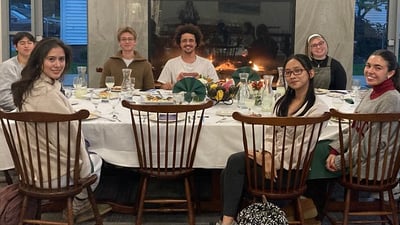Keeping It Real: How Authenticity Makes All the Difference on Campus

 Pop open your social media feed for a second. What do you see? Spicy memes, algorithmic ads, and AI-written posts all rolled into one platform. With all that noise, I think that we’re all looking for something a little more human. Gen Z, and frankly Gen Alpha, is no exception. As digital natives, they’ve come of age in an era where parasocial relationships compete with in-person ones, leaving little room for deep connection. What they’re really craving: something more personal.
Pop open your social media feed for a second. What do you see? Spicy memes, algorithmic ads, and AI-written posts all rolled into one platform. With all that noise, I think that we’re all looking for something a little more human. Gen Z, and frankly Gen Alpha, is no exception. As digital natives, they’ve come of age in an era where parasocial relationships compete with in-person ones, leaving little room for deep connection. What they’re really craving: something more personal.
Combating the Cringe on Campus
What does this mean for campuses and the partners that serve them? According to a recent YPulse session, “cringe” is the new red flag for today’s students. Digging in, it’s easy to see why. “Cringe” is characterized by performative, disingenuous behavior. It’s “trying too hard” on steroids, and it’s the polar opposite of authenticity. The aversion is so strong in Gen Z that 59% won’t engage with (or buy from) a brand that acts inauthentically. Instead, they seek out brands that pursue interesting collaborations, create memorable content with real employees and cool mascots, and have fun commenting on viral posts. In a world where so much can now be created and curated — and thereby considered fake — it’s clear that today’s college students want honesty and true authenticity.
The feeling is mutual on campuses across the country. In the second chapter of the 2025-2026 President to President thought leadership series, the President of St. Thomas University, David A. Armstrong, J.D., weighs in on how colleges can combat the cringe and meaningfully connect with students. In, “The Students See Everything,” Armstrong describes how he fosters a culture of authenticity through simple acts, such as pushing up his sleeves to give freshmen a hand on move-in day. One of his favorite places to connect with students is in the dining hall, and it’s no wonder. Campus dining is about so much more than the food on the plate. In fact, food is the number one way students connect on campus. By making time to engage with students over a meal, Armstrong opens the door for meaningful moments of connection and belonging, where every member of the campus community feels seen, heard, and valued.
I’ve had similar experiences throughout my career when it was beneficial for me to pause and take a moment to give others the opportunity to feel seen and valued for their unique perspectives; it’s truly one of the strengths of Sodexo’s People First mentality. While working as a unit-based marketing manager for Sodexo, I would often hear from a student with celiac disease who was concerned that the dining hall was lacking meal options that would accommodate his needs. He became a vocal advocate not only for himself but for other students with similar dietary needs and challenged our claims of providing an inclusive dining experience.
Recognizing the validity of his concerns, we invited him to join the Student Culinary Council, where his contributions directly impacted feedback provided for Sodexo’s Simple Servings pilot, our now award-winning, allergen-safe resident dining station. Over time, this student transformed into a passionate advocate for resident dining, starring in promotional videos, partnering with the marketing team, and helping create a sense of belonging for students with dietary restrictions. We not only improved our offerings but also empowered a student and many of his peers to lead, develop new skills, and be their authentic selves — demonstrating the impact of listening, inclusion, and channeling student voices into positive change.
Making a Difference One Meal at a Time
By creating opportunities for authentic connection, campus dining is helping students find a sense of belonging. Through our 2024-2025 Sodexo Student Lifestyle Survey, we’ve consistently seen how campus dining can make a meaningful impact on student engagement and well-being.
- 84% of students prioritize a friendly atmosphere.
- 70% of students seek a sense of community on campus.
- 49% of students want a campus where they feel confident that they will be able to make friends.
- 50% more students report that participating in a meal plan keeps them connected with the campus community (compared to 2022 findings).
Sparking Campus Connections
Part of my role at Sodexo is to help students form authentic connections, and it’s one of my favorite things about my job. The Spark engagement series has already made a huge impact, and I love hearing from our campus partners about how they’ve used our Spark initiatives.
 For example, our partners at Hobart and William Smith Colleges saw the Spark Community Table Initiative as the perfect way to welcome first-generation students to campus and give them a chance to build relationships over a casual evening meal. The invitation-only event gathered a small cohort of students who were asked to RSVP with a recipe ingredient they associated with home and family. Sodexo Executive Chef Andre Jaquet then used their suggested ingredients to conjure up a magical three-course meal served family-style to encourage authentic interaction. The students immediately felt at ease in the intimate group setting as they socialized beside a cozy fire and shared fond food memories behind their suggested ingredients.
For example, our partners at Hobart and William Smith Colleges saw the Spark Community Table Initiative as the perfect way to welcome first-generation students to campus and give them a chance to build relationships over a casual evening meal. The invitation-only event gathered a small cohort of students who were asked to RSVP with a recipe ingredient they associated with home and family. Sodexo Executive Chef Andre Jaquet then used their suggested ingredients to conjure up a magical three-course meal served family-style to encourage authentic interaction. The students immediately felt at ease in the intimate group setting as they socialized beside a cozy fire and shared fond food memories behind their suggested ingredients.
And that’s just the beginning. Spark is a dynamic engagement strategy that we update regularly with new ideas and events that meet students where they are now and ensure that we stay authentic.
Making a Lasting Impact
Authenticity is about so much more than fun events. At its core, it’s about how employees know, understand, and interact with students. Our Experiences Matter training helps employees understand the impact of their work and deliver exceptional service that helps students feel welcomed and comfortable, which in turn helps them be their true selves and create authentic connections.
Visiting campuses around the country, I get to see the meaningful impact our efforts around authentic connection and belonging have on students’ lives. And I’m proud of the work Sodexo is doing to ensure that students aren’t just participants but leaders in creating communities that they can call home.